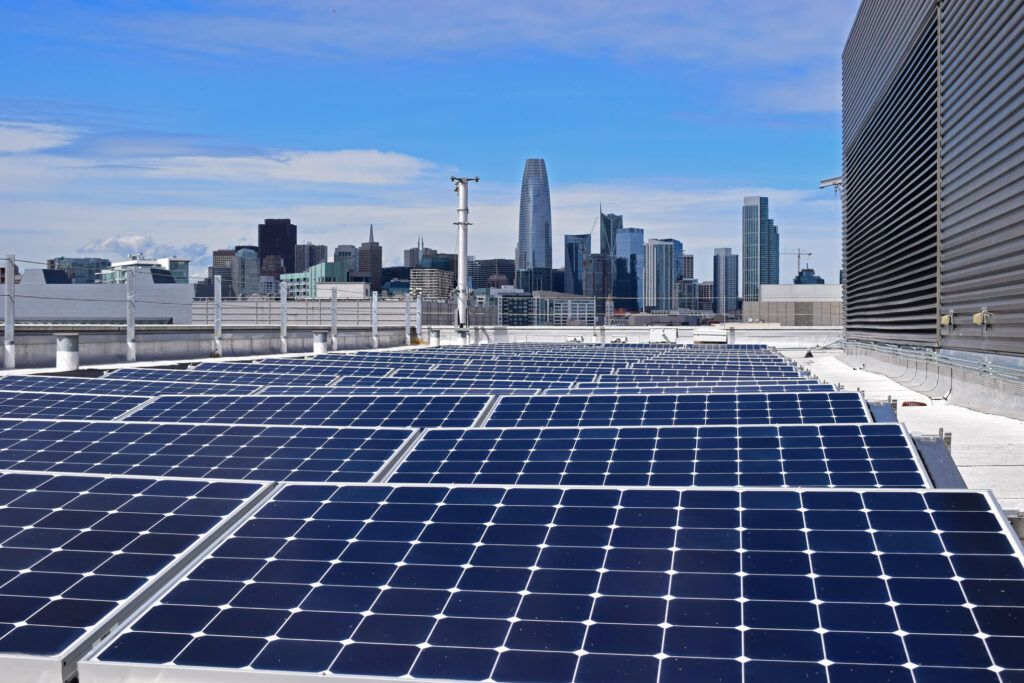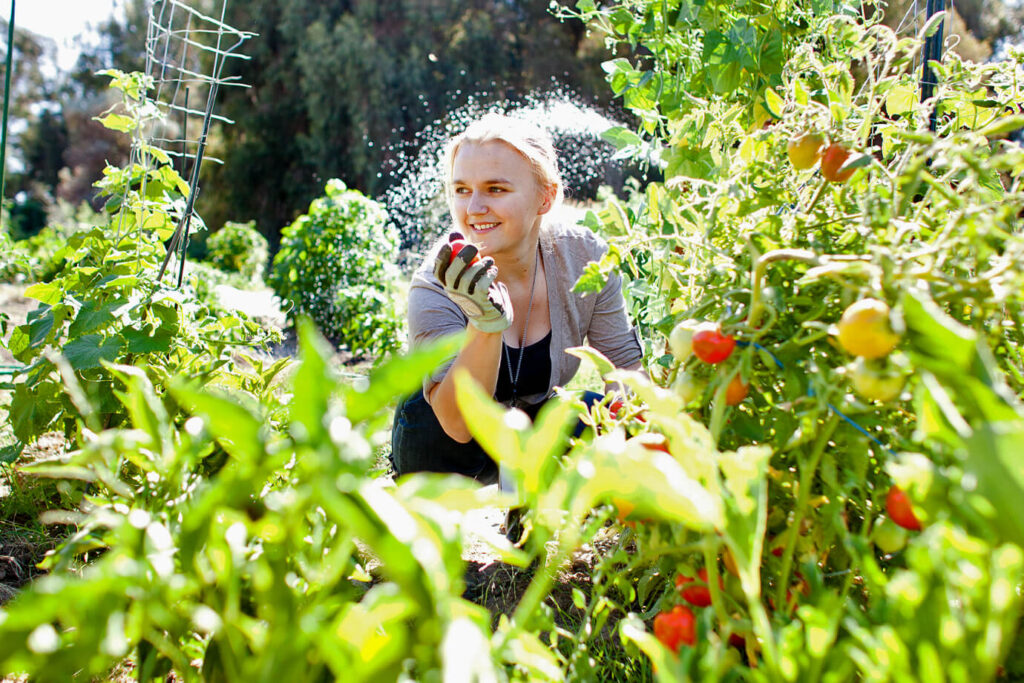Commitment
The 2022 Annual Report on Sustainable Practices explores UC’s community partnerships related to sustainability.

Letter from
the President
For decades, the University of California has been at the forefront of studying the climate crisis and developing practical solutions.
Over the past year, we felt the urgency of addressing the growing impacts of climate change as communities across California — and the country — experienced historic droughts, heat waves, wildfires and other extreme weather events exacerbated by a warming planet. But we also saw the potential for rapid and effective climate action as elected officials, institutions and communities came together around shared goals.
In the 2022-23 state budget, the California Legislature and Governor Gavin Newsom allocated $185 million in support of the University’s trailblazing work on climate change. These resources will be used to fund community-tailored solutions to meet California’s climate goals and needs, ensure that our communities are prepared and resilient and prevent future disasters. This is a great example of the many ways that the University of California is working to leverage state, federal and private funding to accelerate climate research and innovation.
University of California Health also joined health systems and medical companies across the nation in a new national pledge to decarbonize the health sector and increase the resilience of our medical facilities. Meanwhile, UC academic health centers continued to make improvements in clean electricity, energy efficiency, waste reduction, water conservation and sustainable food procurement.
As living laboratories of sustainability, UC campuses also led by example by reducing their emissions and waste and charting a path toward fossil-free operations. Meanwhile, in our classrooms and labs, the University continued to train the next generation of climate leaders in areas as diverse as green transportation, low-carbon construction, energy efficiency, sustainable agriculture and food procurement and more.
Looking ahead, I am energized by the University’s ongoing efforts to incorporate climate leadership and action into every aspect of our work, and to use our unique research capabilities and expertise to benefit the public good. Together, we have the power to meet this moment and create a more sustainable and resilient future rooted in climate equity and justice.

Michael V. Drake, MD
President, University of California

Letter from the
AVP of Capital Programs,
Energy & Sustainability
More than 15 years ago, the University of California began setting aggressive greenhouse gas reduction goals as a leader in the state’s efforts to battle climate change. UC’s actions to date provide much to celebrate. Our campuses and academic health centers have implemented over 1,000 energy efficiency projects, resulting in cumulative avoided utility costs of more than $300 million. UC Clean Power (our electric company) has been providing carbon-free electricity to eligible campuses and academic health centers since 2019, and UC has also constructed over 100 renewable energy projects. Despite our success in becoming more energy efficient and transitioning to renewable and carbon-free electricity, UC remains challenged in phasing out natural gas for heating, cooling and electricity generation. Of UC’s remaining greenhouse gas emissions, 80% are from natural gas combustion. Decarbonizing power production while maintaining reliability and keeping energy costs down is a key challenge for UC — just as it is for the state of California.
We’re pleased that the fiscal year 2022–23 state budget included a $185 million investment in UC’s trailblazing research on climate change. That state budget also includes $83 million for UC Berkeley to begin implementation of its Clean Energy Campus goal of a 100% electrified and renewable energy microgrid by 2028. Because UC’s capital and deferred maintenance needs are immense, the state budget’s $208 million for capital improvements and infrastructure projects across our system is much appreciated. A portion of that funding will support decarbonization studies to further develop fossil-free pathways at every UC campus.
“Community partnerships” is the theme of this year’s sustainability report. UC’s Carbon Neutrality Initiative (CNI) has been funding several systemwide projects supporting community partnerships that lead toward equitable climate action and climate justice, such as the Community-Academic Partnerships to Advance Equity-Focused Climate Action program and the Framework for Incorporating Environmental & Climate Justice into Climate Action. This year, CNI is also funding student fellows to engage with on- and off-campus communities to help their campuses center justice, equity, inclusion and diversity in their respective campus climate action plans and new climate resilience plans.
Our campuses and academic health centers are working with their communities on climate change in other ways as well. For example, ecologists at UC Riverside are leading a $1 million plant protection project that will help Southern California’s tribal nations adapt to climate change; the newly launched University of California Center for Climate, Health and Equity aims to harness the expertise and leadership of the health sector to drive ambitious climate action that prioritizes the health, equity and respect of all communities; and UC’s new Climate Stewards program, a public education and service effort by the University of California Agriculture and Natural Resources, is designed to improve climate understanding and empower community-level stewardship.
I invite you to read the many stories of community partnerships featured throughout the 2022 Annual Sustainability Report.

David Phillips
Associate Vice President, Capital Programs, Energy & Sustainability
Policy Areas
The University of California’s sustainability commitment began in 2003 with a Regental action that led to the adoption of the Presidential Policy on Green Building Design and Clean Energy Standards in 2004. Since adopting that policy, UC has expanded the scope of the Sustainable Practices Policy to include climate protection, transportation, sustainable building operations, zero waste, procurement, food, water, health and well-being, and health care facilities.

The Sustainable Practices Policy includes all 10 campuses, six academic health centers, UC Agriculture and Natural Resources, Lawrence Berkeley National Laboratory and the UC Office of the President.
The UC Policy on Sustainable Practices can be accessed online, and a summary is available below. UC’s sustainability data summarizes progress toward the goals.
Climate
- All campuses, including their academic health centers, will maintain greenhouse gas emissions at or below 1990 levels.
- All campuses, including their academic health centers, will achieve climate neutrality from scope 1 and 2 sources by 2025.
- All campuses, including their academic health centers, will achieve climate neutrality from specific scope 3 sources (as defined by Second Nature’s Climate Commitment) by 2050 or sooner.
Energy
- Energy efficiency: Reduce each location’s energy use intensity by an average of at least 2% annually.
- Clean electricity: Obtain 100% clean electricity at each campus and health location by 2025. UC Clean Power will provide 100% clean electricity to participating locations.
- On-campus combustion: Increase biogas combustion to at least 40% of on-site natural gas combustion at each campus and health location by 2025.

Food Service
- Procure 25% sustainable food as defined by the Association for the Advancement of Sustainability in Higher Education’s Sustainability Tracking, Assessment and Rating System (AASHE STARS) at each campus and 30% sustainable food as defined by Practice Greenhealth at each academic health center by 2030.
- Develop a plant-forward menu goal.

General Sustainability Performance Assessment
- All undergraduate campuses must achieve an Association for the Advancement of Sustainability in Higher Education’s Sustainability Tracking, Assessment and Rating System’s (AASHE STARS) Silver rating and strive for Gold by 2023.
Green Building
New Buildings and Renovations
- Design and construct all new buildings and major renovations to a minimum LEED BD+C (Building Design and Construction) Silver rating.
- Design and construct other renovation projects (except acute care facilities) with a cost over $8 million to a minimum LEED ID&C (Interior Design and Construction) certified rating.
- Energy-efficient design:
- Acute care/hospital facilities and medical office buildings: Outperform the American Society of Heating, Refrigerating and Air-Conditioning Engineers (ASHRAE) standard 90.1-2010 by at least 30% or meet UC’s whole-building energy performance targets.
- All other buildings: Outperform the energy requirements of the California Building Code by at least 20% on all new construction and major renovation projects or meet UC’s whole-building energy targets.
- Prohibit on-site fossil fuel combustion (e.g., natural gas) for space or water heating in all new buildings and major renovation projects (except those projects connected to an existing campus central thermal infrastructure).
Existing Building Operations and Maintenance (EBOM)
- Seek to certify as many buildings as possible through the LEED EBOM rating system at each campus.
Health and Well-Being
By the end of 2022, the UC Healthy Campus Network will review the strengths and gaps in the UC Sustainable Practices Policy and make recommendations for integration based on:
- Environmental and human health co-benefits.
- Social, physical and emotional well-being.
- Health equity.
Procurement
- Achieve full compliance with required level green spend criteria per product category; target to be reached within three fiscal years after a category is added to the Sustainable Procurement Guidelines.
- Reach 25% preferred level green spend per product category; target to be reached within three fiscal years after a category is added to the Sustainable Procurement Guidelines.
- Reach 25% economically and socially responsible spend; target to be reached within five fiscal years of adoption of this section in the Sustainable Procurement Guidelines.
- Allocate a minimum of 15% of the points utilized in competitive solicitation evaluations to sustainability criteria.
Sustainable Building Operations and Labs
- Implement an ongoing Green Labs assessment program and, in total, assess three research groups at each campus.
- Identify existing single-pass cooling systems and constant-flow sterilizers and autoclaves in laboratories and develop a plan for replacement at each campus.
Transportation
Fleet
- All sedan and minivan acquisitions will be zero-emission or plug-in hybrid vehicles, except for public safety vehicles with special performance requirements.
- At least 50% of all vehicles acquired by each UC location after July 2023 will be zero-emission or plug-in hybrid.

Commute
Each location shall strive to:
- Reduce its percentage of employees and students commuting by single-occupancy vehicles (SOVs) by 10% relative to its 2015 SOV commute rates by 2025.
- Have no more than 40% of its employees and no more than 30% of all employees and students commuting to the location by SOV by 2050.
- Have at least 4.5% of commuter vehicles be zero-emission by 2025.
- Have at least 30% of commuter vehicles be zero-emission by 2050.
UC Health
Each academic health center will:
- Obtain 100% clean electricity by 2025.
- Adopt energy performance targets for acute care centers and medical office buildings.
- Maintain membership in Practice Greenhealth, a nonprofit dedicated to health care sustainability, and submit annual sustainability data for awards.
- Achieve a target of 25 pounds of total waste as defined by Practice Greenhealth per adjusted patient day by 2025 and strive for 20 pounds of total waste per adjusted patient day by 2030.
- Reduce growth-adjusted potable water consumption 20% by 2020 and 36% by 2025, when compared to a three-year average baseline of fiscal year 2005–06, fiscal year 2006–07, and fiscal year 2007–08.
- Procure 30% sustainable food as defined by Practice Greenhealth.
Water
- Reduce growth-adjusted potable water consumption by 36% by 2025, when compared to a three-year average baseline of fiscal year 2005–06, fiscal year 2006–07, and fiscal year 2007–08 at each location.
Zero Waste
- Reduce per capita municipal solid waste generation to 25% below fiscal year 2015–16 levels by 2025 and 50% below fiscal year 2015–16 levels by 2030 at each campus.
- Divert 90% of municipal solid waste from the landfill at each campus.
- Reduce and eliminate single-use plastic items such as bags, foodware accessory items and beverage bottles.
- Prohibit the sale, procurement and distribution of packaging foam.
Timeline of Sustainability
For many decades, the University of California has been committed to sustainability in its operations.
 Sustainability Annual Report 2022
Sustainability Annual Report 2022